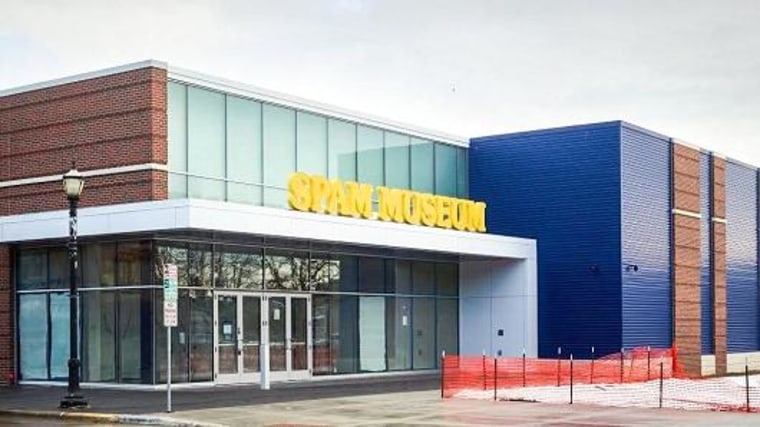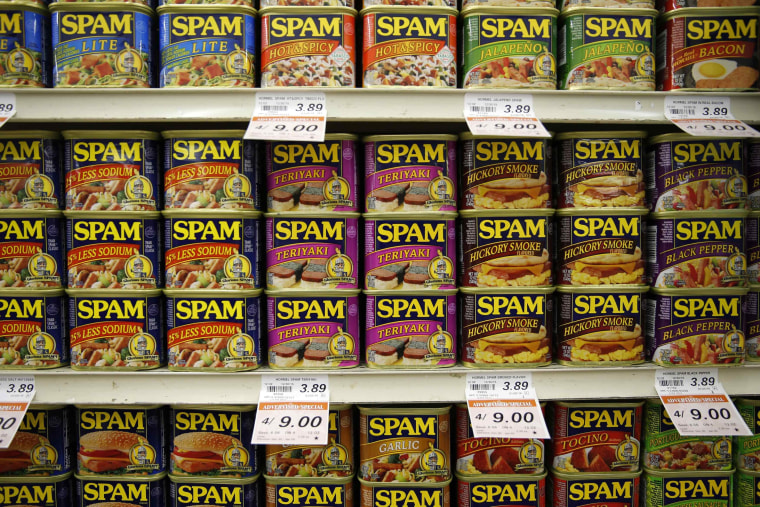Too bad Spam-filled chocolate Easter eggs aren't real, because they might have found a receptive audience in a new location.
The gag item, announced in 2013 as an April Fool's Day marketing trick, would likely be a hit at the Spam Museum, reopening next month in Austin, Minnesota. Austin is the home town of the iconic tinned meat producer, Hormel Foods Corp.
When its doors open April 22, the expanded museum won't have the fictional Easter eggs, but it will have other unusual Spam varieties — including teriyaki and macadamia nut — which speak to the history and production of the spiced ham product invented nearly eight decades ago.

"Where else can you be served meat cubes on pretzel sticks while learning how cans of Spam helped win World War II?" said Doug Kirby, publisher of Roadside America. "The museum is a great example of how a business can embrace its own pop culture legacy and produce an amusing tourist attraction."
SPAMples, the Spam Museum's version of free samples, will continue as well — something that excites the meat's die-hard fans.
"We'll have new galleries," said Nicole Behne, marketing director of grocery products at Hormel Foods, "but we're keeping and updating several popular ones, including one exploring Spam's connection to the military and the production line game where guests can simulate making Spam."
Since 2001, the Spam Museum has welcomed "hundreds of thousands" of visitors, said Behne — first from its location in a mall and, later, from a building attached to Hormel corporate headquarters just off Interstate 90.
However, stopping at the museum didn't require a drive through Austin (population: 25,000), which meant most visitors never ventured into the town's historic shop- and restaurant-filled downtown.
So when it came time for a new and bigger spot for the museum, members of Vision 2020, a community group working to improve the quality of life in Austin by the year 2020, urged Hormel to move the museum to Main Street.
"You can imagine how many visitors that could bring to town to spend their money in local businesses," said Vision 2020 coordinator Greg Siems. "That can't be replicated by anything else in town."
Hormel, the town's largest employer, agreed.
"We decided it was a great opportunity to help bring economic development downtown," said Behn., "Instead of seeing the museum and getting back on the highway, people can eat, shop and play in the downtown and support the area."
The question now is whether the effort will work. No formal studies have been commissioned, but town officials are hoping for the same effect in Austin that was seen in Le Mars, Iowa, a town known as the "Ice Cream Capital of the World."
In 2011, Wells Enterprises, makers of Blue Bunny Ice Cream, moved the destination Blue Bunny Ice Cream Parlor and Museum from a spot out on the highway into a historic building downtown.
The increased foot traffic produced a halo effect for town activity.
"It has absolutely made a difference," said Jessica Brownmiller, manager of the Le Mars Convention and Visitors Bureau.
"It pulls people off of Highway 75 into downtown, and businesses in downtown have definitely expanded," she said. "The more traffic that comes to the ice cream parlor, the more chances there are for visitors to frequent local businesses."
Finishing touches are being put on the Spam Museum, which has scheduled its soft opening for April 22 and a grand opening in July as part of Hormel's 125th anniversary celebration.
The museum will have a Spam-themed gift shop but no café or restaurant. Behne said the plan is for museum staff, or "Spambassadors," to distribute handouts pointing visitors to nearby restaurants (serving up Spam-themed dishes), attractions and shops eager to welcome new visitors.
One of those shops will be Hastings Shoe and Repair, which has been operating in Austin since 1909 and is now run by Jean Hastings and her daughters.
"When the museum was out of town, we never got too much traffic here in town," said Hastings. "But once it opens downtown there will be busloads of people who might spend a few hours in Austin and take the time to walk around."
